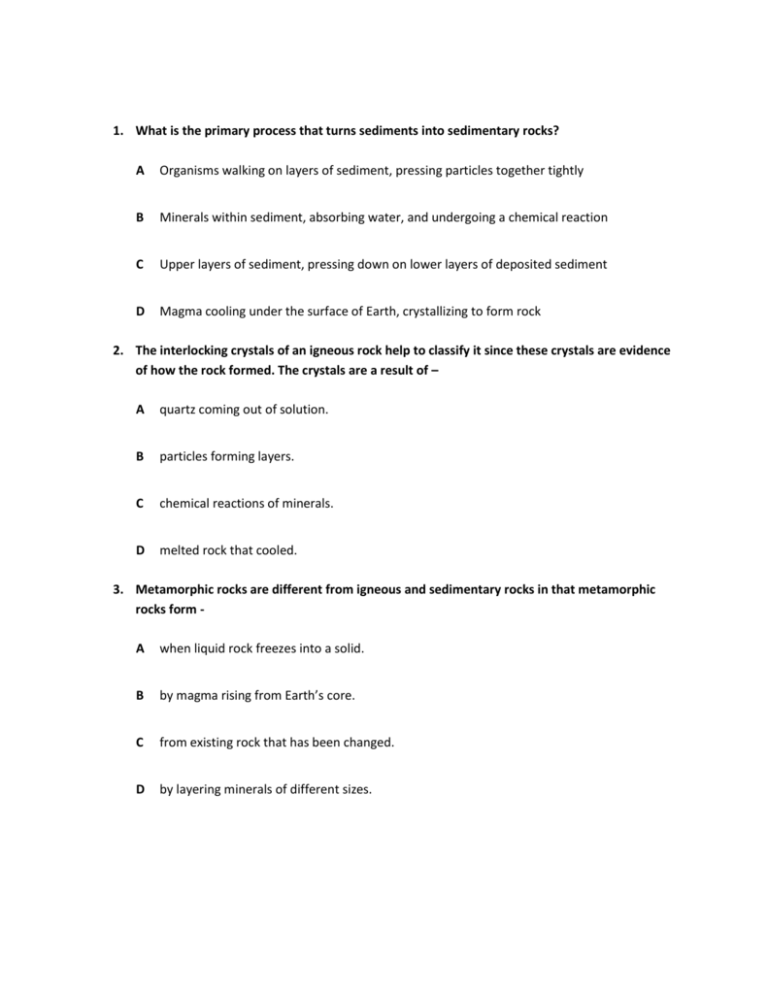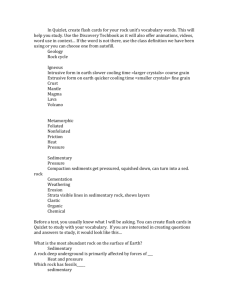What is the primary process that turns sediments into sedimentary
advertisement

1. What is the primary process that turns sediments into sedimentary rocks? A Organisms walking on layers of sediment, pressing particles together tightly B Minerals within sediment, absorbing water, and undergoing a chemical reaction C Upper layers of sediment, pressing down on lower layers of deposited sediment D Magma cooling under the surface of Earth, crystallizing to form rock 2. The interlocking crystals of an igneous rock help to classify it since these crystals are evidence of how the rock formed. The crystals are a result of – A quartz coming out of solution. B particles forming layers. C chemical reactions of minerals. D melted rock that cooled. 3. Metamorphic rocks are different from igneous and sedimentary rocks in that metamorphic rocks form A when liquid rock freezes into a solid. B by magma rising from Earth’s core. C from existing rock that has been changed. D by layering minerals of different sizes. 4. Which of the following processes is one of the early steps in the formation of sedimentary rock? A Weathering of existing rock B Crystallization of molten minerals C Melting of rock in volcanoes D Chemical reactions that produce heat 5. Igneous rock can be changed into sedimentary rock when igneous rocks – A that form mountains get pushed together. B are weathered and the fragments deposited. C melt to form layers of different minerals. D put out by volcanoes create new land. 6. Igneous rocks and metamorphic rocks have similar formation, in that they both – A require extreme heat. B always form from sediments. C cool to form distinct layers. D often contain fossil organisms. 7. In order for a rock to be classified as igneous, what must have happened during its formation? A Solid rock changing under pressure B Liquid rock changing its physical state C Small rocks becoming cemented together D Layered rock breaking into smaller pieces 8. Sedimentary rock can be changed into igneous rock if sediments are – A compacted. B deposited. C weathered. D melted. 9. Igneous and sedimentary rocks could each be changed into metamorphic rock if they are changed by A weathering. B organisms. C pressure. D cementation. 10. Which of the following processes might be one of the first steps in the formation of sedimentary rock? A Glaciers breaking down rock B Liquid magma cooling and hardening C Rock melting deep underground D Minerals changing due to pressure 11. Geologists might recognize a metamorphic rock by distorted, wavy layers because they were caused by A compaction and cementation. B melting and crystallizing. C erosion and deposition. D pressure and heat. 12. Sedimentary rock can contain evidence of life because of all the following are properties of sedimentary rock EXCEPT A it can be made from mud. B it is created under the ocean. C it is formed by melting rock. D it can contain organic material. 13. Sedimentary rocks often contain horizontal layers because they are formed by the A deposition of sediment. B movement of tectonic plates. C heating of organisms. D cooling of melted rock. 14. Sedimentary rock can be changed into metamorphic rock if it is A weathered and eroded by ocean waves. B exposed to extreme heat underground. C broken down by heating and cooling. D cemented with minerals carried in water. 15. All of the following processes are the ones that lead directly to the formation of sedimentary rock EXCEPT A deposition of rock fragments. B freezing of water in cracks in rock. C melting of rock deep underground. D movement of wind that carries earth material.






